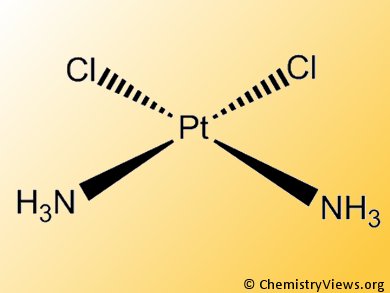Cisplatin, cis-dichlorodiamineplatinum (II) (pictured), is a chemotherapeutic agent used for many forms of cancer. Its formulation as nanodrugs is however challenging. Poulomi Sengupta, Brigham and Women’s Hospital, Cambridge, USA, used a strategy based on supramolecular chemistry to develop self-assembling cholesterol-succinic acid-cisplatinum II-based nanoparticles (SACNs).
These possess an enhanced antitumor activity compared to free cisplatin. Their increased efficacy is attributable to an efficient release, at the tumor site, of active platinum obtained by introducing the monocarboxylato and O→Pt coordination environment between the platinum and the cholesterol succinic acid conjugate.
This feature together with a reduced nephric and systemic toxicity renders SACNs new promising platinum based drugs.
- Cholesterol-tethered platinum II-based supramolecular nanoparticle increases antitumor efficacy and reduces nephrotoxicity,
P. Sengupta, S. Basu, S. Soni, A. Pandey, B. Roy, M. S. Oh, K. T. Chin, A. S. Paraskar, S. Sarangi, Y. Connor, V. S. Sabbisetti, J. Kopparam, A. Kulkarni, K. Muto, C. Amarasiriwardena, I. Jayawarden, N. Lupoli, D. M. Dinulescu, J. V. Bonventre, R. A. Mashelkar, S. Sengupta,
Proc. Nat. Acad. Sci. 2012, 109(28), 11294–11299.
DOI: 10.1073/pnas.1203129109




